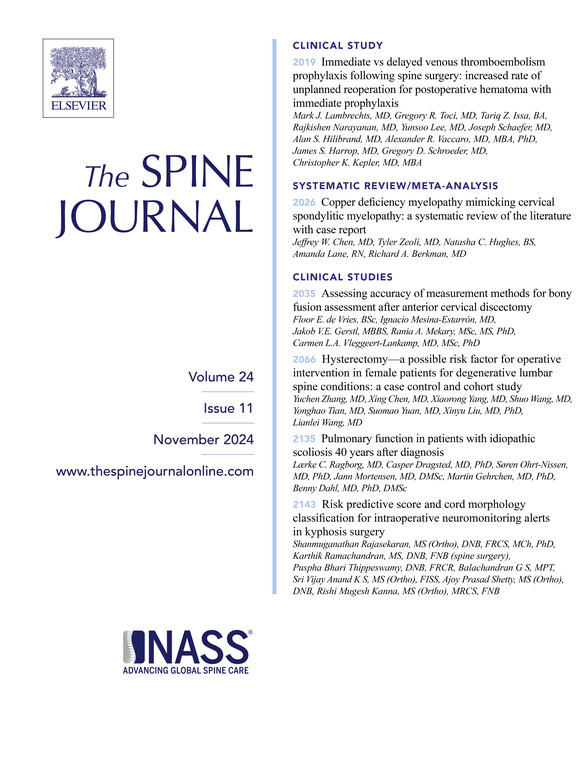将全身肿瘤代谢负担纳入非小细胞肺癌脊柱转移患者的现有预后模型中
IF 4.9
1区 医学
Q1 CLINICAL NEUROLOGY
引用次数: 0
摘要
背景情况:许多预后模型被用于转移性脊柱肿瘤的手术决策和预后判断。然而,这些模型往往没有考虑到全身肿瘤负荷,而这可能对转移性癌症的预后至关重要。肿瘤负荷的潜在替代标志物--全身代谢性肿瘤负荷(wMTB)可通过18F-氟代葡萄糖正电子发射断层扫描(18F-FDG PET)图像获得的总病变糖酵解(TLG)计算得出。目的:我们旨在通过纳入脊柱转移的非小细胞肺癌(NSCLC)患者的wMTB,提高现有模型的预后能力:设计:利用电子病历和生存数据进行回顾性分析:在这项研究中,我们纳入了 74 名经影像证实患有脊柱转移的非小细胞肺癌患者:在预后评分中加入 wMTB 后,综合鉴别改善指数(IDI)的增加情况:方法:回顾性收集入组患者的基线数据、癌症特征和生存状况。计算所有患者的五个广泛使用的预后评分(富田评分、片桐评分、德桥评分、全球脊柱肿瘤研究组评分[GSTSG]、新英格兰脊柱转移评分[NESMS])和 TLG 指数。分析了生存时间、预后模型和 TLG 值之间的关系。通过将重要的 TLG 指数纳入重要的现有模型,验证了预后能力的提高:结果:在目前的预后模型中,Tomita(表皮生长因子受体野生型)、Katagiri、GSTSG 和 Tokuhashi 与患者的生存期显著相关。在TLG指数中,LogTLG3与生存率有明显关系。将LogTLG3纳入重要的预后模型后,所有模型中的IDI指数在三年前均为正数:本研究表明,纳入 wMTB 提高了当前转移性脊柱肿瘤预后模型的预后能力。本文章由计算机程序翻译,如有差异,请以英文原文为准。
Incorporation of whole-body metabolic tumor burden into current prognostic models for nonsmall cell lung cancer patients with spine metastasis
BACKGROUND CONTEXT
Numerous prognostic models are utilized for surgical decision and prognostication in metastatic spine tumors. However, these models often fail to consider the whole-body tumor burden into account, which may be crucial for the prognosis of metastatic cancers. A potential surrogate marker for tumor burden, whole-body metabolic tumor burden (wMTB), can be calculated from total lesion glycolysis (TLG) obtained from 18F-Fludeoxyglucose positive emission tomography (18F-FDG PET) images.
PURPOSE
We aimed to improve prognostic power of current models by incorporating wMTB for nonsmall cell lung cancer (NSCLC) patients with spine metastases.
DESIGN
Retrospective analysis using a review of electrical medical records and survival data.
PATIENT SAMPLE
In this study, we included 74 NSCLC patients with image proven spine metastases.
OUTCOME MEASURES
Increase in Integrated Discrimination Improvement (IDI) index after incorporation of wMTB into prognostic scores.
METHODS
Enrolled patients’ baseline data, cancer characteristics and survival status were retrospectively collected. Five widely used prognostic scores (Tomita, Katagiri, Tokuhashi, Global Spine Tumor Study Group [GSTSG], New England Spine Metastasis Score [NESMS]), and TLG indexes were calculated for all patients. The relationships among survival time, prognostic models and TLG values were analyzed. Improvement of prognostic power was validated by incorporating significant TLG index into significant current models.
RESULTS
Among current prognostic models, Tomita (EGFR wild-type), Katagiri, GSTSG and Tokuhashi were significantly related to patient survival. Among TLG indexes, LogTLG3 was significantly related to survival. Incorporation of LogTLG3 into significant prognostic models resulted in positive IDI index until 3 years in all models.
Conclusions
This study showed that incorporation of wMTB improved prognostic power of current prognostic models of metastatic spine tumors.
求助全文
通过发布文献求助,成功后即可免费获取论文全文。
去求助
来源期刊

Spine Journal
医学-临床神经学
CiteScore
8.20
自引率
6.70%
发文量
680
审稿时长
13.1 weeks
期刊介绍:
The Spine Journal, the official journal of the North American Spine Society, is an international and multidisciplinary journal that publishes original, peer-reviewed articles on research and treatment related to the spine and spine care, including basic science and clinical investigations. It is a condition of publication that manuscripts submitted to The Spine Journal have not been published, and will not be simultaneously submitted or published elsewhere. The Spine Journal also publishes major reviews of specific topics by acknowledged authorities, technical notes, teaching editorials, and other special features, Letters to the Editor-in-Chief are encouraged.
 求助内容:
求助内容: 应助结果提醒方式:
应助结果提醒方式:


